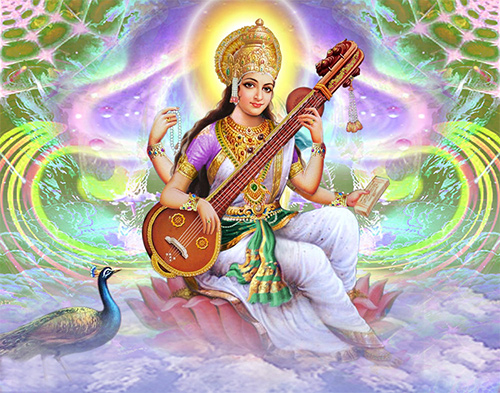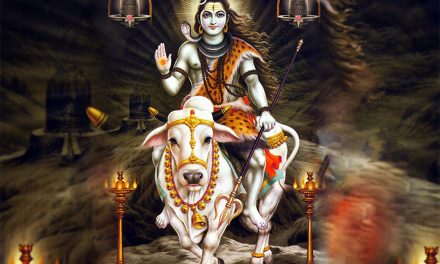
Goddess Saraswati’s birthday is celebrated every year as Saraswati Puja, on the 5th day of the bright fortnight of the lunar month of Magha. The festival honors the Supreme Deity of Wisdom and Learning and is also known as Vasant Panchami or Shree Panchami, the welcoming of spring time. Thus, this auspicious day has of religious, seasonal and social meaning. It is celebrated with tremendous enthusiasm in homes, schools, colleges, and temples alike. The epitome of knowledge and consciousness, Goddess Saraswati is also considered the mother of the Vedas. Her chants known as Saraswati Vandana often start and conclude Vedic teachings.
Saraswati Puja is celebrated across India. On the day of the puja, the color yellow dominates. Yellow is associated with the goddess as the light of enlightenment is yellow. People dress in yellow, especially young girls who dress in yellow sarees and the womenfolk make yellow sweets and savories. One is also supposed to feed Brahmins on that day, with the feeling that the food is being passed on to their ancestors. People celebrate this festival with a new sense of positivity and a spirit of embracing knowledge. Pushpanjali, the offering of flowers with prayers are presented to her in shrines. The incense presented to the Goddess should be very specific. One can use almond, lavender or rosemary for wisdom and clarity and cinnamon infused incense for creativity. One can also light white and yellow candles.
Puja marquees or pandals are set up in colleges and schools for elaborate rituals for blessing the students of the institutions and honing the flow of knowledge there. In most of the clay idols of the Devi, she is majestically seated on a white lotus (the ultimate depiction of supreme reality and knowledge) in the yogic position of Padmasana. She is draped in a pure white silk saree and radiates purity and tranquility. Her vahana is a white swan, which again symbolizes Sattwa Guna (purity and discrimination). She also wears a crescent moon on her brow. Her four hands signify four aspects of learning, namely mind (manas), intellect (buddhi), alertness (chita) and ego (ahankara). Her presence in all four aspects depicts her omnipresence and omnipotence. She also carries a rosary, displaying the importance of meditation and concentration, as well as the Vedas, depicting supreme knowledge.
The scholarly and erudite confer a lot if significance to the worship of this Goddess. According to the ancient Vedic texts, the Goddess is a water deity. She is venerated for cleansing, nourishing and enriching supremacies. She is also said to have invented Sanskrit, the most distinguished of all languages, used in the greatest scriptures and scholarship known to mankind. School bags, text books, notebooks, pencil boxes, pens, pencils, erasers etc. are kept at the Devi’s feet for her blessings during Saraswati Puja. Children gleefully use their possessions after the puja. Students write their names, addresses and the roll numbers on chits and put it in a hundi, placing it next to the Goddess’ idol for her blessings. Ma Saraswati is said to bless the children with good results and create a desire in them for acquiring wisdom and knowledge. One is not supposed to write on that day but offer prayers instead. She blesses human beings with the power of speech, wisdom and learning. This is why she is considered to be a Vac Devi is as well.
Young people especially enjoy this festival with fun and games. Over time the flying of kites has become a tradition of this festival. There are many music shows, theatres and cultural programs staged at night. As the goddess is the wife of Lord Brahma, she enables the execution of whatever Brahma generates with his artistic intellect. Hence, she is considered to be the goddess of the creative arts. The Patron Deity of the Arts is venerated by singers and musicians with utmost dedication and devotion. It is said that with the Goddess’ divine grace, people have been gifted the ability to write or compose poems and songs and create music. The goddess herself plays a veena, Indian stringed instrument, which is often depicted in her imagery. This shows that music creates harmony in this world.
In the sacred Matsya Purana, it is stated that the goddess evolved from the mouth of Lord Brahma. Her beauty was so enigmatic that the god fell head over heels (and quite literally too) in love with her. She ran in different direction and every time he turned to search for her, a new head appeared. The goddess is said to be the most extraordinary creation of the Lord of Creation. The moon in her brow depicts eternal womanhood.
There is also a story connecting Goddess Saraswati with the immortality of the gods. The gods and the demons mutually agreed to churn the oceanic waters to retrieve soma or amrita, the elixir of life. Mainak Mountain was used as the churning rod while the mighty python Basuki, was the churning rope. When Goddess Saraswati appeared with the goblet of soma ras, the gods were pleased. Rapt by her beauty the demons were lured away. As the gods drank, somehow two demons Rahu and Kethu slipped in. Lord Vishnu noticed them having a drink and immediately slit their throats. The angry asuras swallowed the sun and the moon but as their throats were slit, they could not be retained. This is the origian of solar and lunar eclipses. As the Goddess helped the gods, she was granted a supreme position in heaven.
The deity of Gayatri, the Fountain of Fine Arts and Sciences and the Supreme Representation of Vedanta Knowledge, Goddess Saraswati guides mankind every day. On the special day of her birthday, it’s our responsibility to pay our homage and seek her blessings.
Om Saraswati Mahabhagey, Vidye Kamala Lochaney
Viswarupey Vishalakshmi, Vidyam Dehi Namohastutey
Jaya Jaya Devi, Charachara Sharey, Kuchayuga Shobhita, Mukta Haarey
Vina Ranjita, Pustaka Hastey, Bhagavati Bharati Devi Namohastutey












Jai Maa Saraswati
SARASWATI NAMASTHUBHYAM
VARADE KAMARUPINI
VIDYARAMBHAM KARISHYAMI
SIDDHIR BHAVATHUME SADA
Sub: Cosmological Significance
Goddess Saraswati is a reflector of Cosmic Flow of knowledge – Brahmanyai Namah
Para-Apara Brahma Tatvam Sandhayineem.
The right mode of analysis helps dimensional Knowledge Base- India needs to to wake-up through Space Cosmolgy Vedas interlinks
Very useful information about religion, rivers, diet etc. I am thankful for gaining so much knowledge by reading such articles. thanks, regards
Please check whetherr a correction needed here
Viswarupey Vishalakshmi, Vidyam Dehi Namohastutey – the second word to ‘Vishalakshi’
which means large – wide eyes
vende saraswathi matha